Creating the voice & tone of your product
The article touched on the theme of tonality and voice of the product. The concept in our area is not too much discussed, it is practically not used consciously. And, to be honest, voice and tone are usually included in brand books and similar documents, or are implicitly written in the editorial policies of magazines / newspapers, etc.
I bring to your attention a translation of the article " Creating your product's tone and voice " by Kaja Laura Toczyska. As usual, thanks in advance to everyone who takes the time to read.

Working in a product development team has an undeniable advantage over other types of teams: you can delve into the project. In Growbots (a platform for automating external sales, - approx.), after a year of working on a complete redesign, the stage has come when we were able to focus on polishing and fixing our previous work. Since we did not have a UX writer, it was necessary to complete work on a large release in a short time, and the texts in the application should have been normal anyway. All of these button names, messages, and errors definitely lacked uniformity, and - which I deeply regretted - their own tone and voice.
When calmer times came, I proposed to improve the text part of the application and develop my own tone and voice. Since I first worked with such a project (and my level of English is lower than even among native speakers), I would like to share our process with you. I hope that some of our experience will be useful for your company.
This is how you express the nature of your company in communicating with customers at each contact. This is how you sound, what words you use, what atmosphere you create in your letter. Your tone and voice are everywhere - every message your customers exchange, every text on your site, every slogan in your advertisement.
Your brand can (and should) have a different tone for different types of messages. On my example, I will tell you why. You yourself, and your character does not change much. But your tone largely depends on the situation in which you are, and on the person with whom you communicate. When you talk with your friends, you are probably relaxed, use slang, joke, and sometimes even express yourself. But when you are at the company’s official meeting, you probably follow your own words, take yourself more seriously and try to make a good impression. It is just a change of tone, while remaining the same person.
You need to project this knowledge onto the tone of your brand. When sending messages to the user — for example, errors, tips or feedback — the tone should change slightly. This is very important to indicate when preparing the voice & tone manual.
Now let's move on to the very process of creating recommendations on the tonality and voice of a product / brand, etc.
The first thing I did: quickly looked through the sites of our competitors and their tech support pages for tonality and voice. This simple operation will help you understand how you can distinguish your product / brand from others, as a unique tone and voice can become a huge differentiating factor. Pay attention to the words and phrases that they use, their tone (more formal or everyday?) And consistency among themselves.
Next, I looked at how we communicate with customers now, studied marketing materials (website, blog), and listened to successful negotiations with customers. I selected a few posts that, in my opinion, best reflect our current tone.
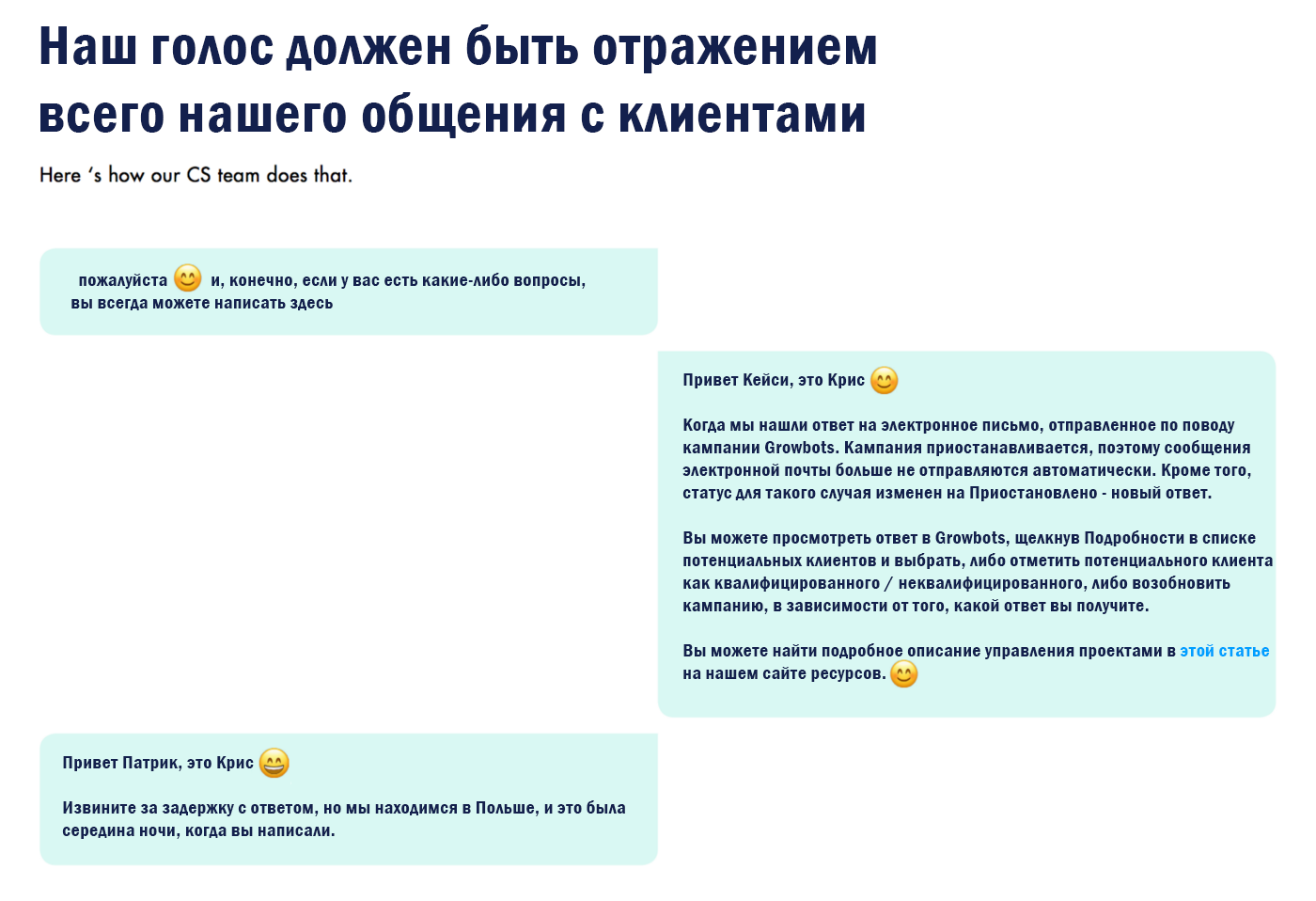
To make sure that everyone has the same idea of our tone and voice, I organized a seminar, inviting people from the team of designers, marketers and customer service managers - people who communicate on behalf of our company every day.
We tried to talk about who our customers are, what they do and how we currently communicate with them. Then we tried to find out how we all see Growbots, highlighting several features that we associate with our company (for example, the desire to be useful, natural in behavior, friendly). We learned that our vision is very similar. Everyone more or less saw Growbots as a young man (we are a startup), very useful, who studied everything on his own and likes to share this knowledge with others.
Our head of the UX, Peter, printed a photograph of a group of people and asked us to point out the person in the photograph, who, in our opinion, is most similar to Growbots. Most people chose the same person, and it really showed us that our vision is very holistic.
Now that we had a human image similar to Growbots (we called it Mark), we did the following exercise, which really helped us translate our vision into something more tangible. We presented that Mark has his own store with data on prospects, and the buyer enters this store. Then we wrote a conversation that we expected to happen in such a situation.
We went through all the scenarios - from the beginning of relations with the client, through some of his problems and small achievements, before the client decided to stop using our services. In different cases, we changed the tone. For example, when a client was angry that something was not working, Mark was very reassuring and helping. And when everything worked out for the client, Mark was cheerful and encouraging, using less formal words.
Having finished the work, we assigned one category to each phrase of Mark:
Then we analyzed these phrases and marked them in the matrix. The matrix consisted of two axes:
Through this exercise, we were able to correlate the types of messages and the tone that we want to use in these situations.

With all this information, I was able to create a guide for our tone and voice. It consisted of several sections with 1–6 slides per section. Below you can see slide samples for each section:
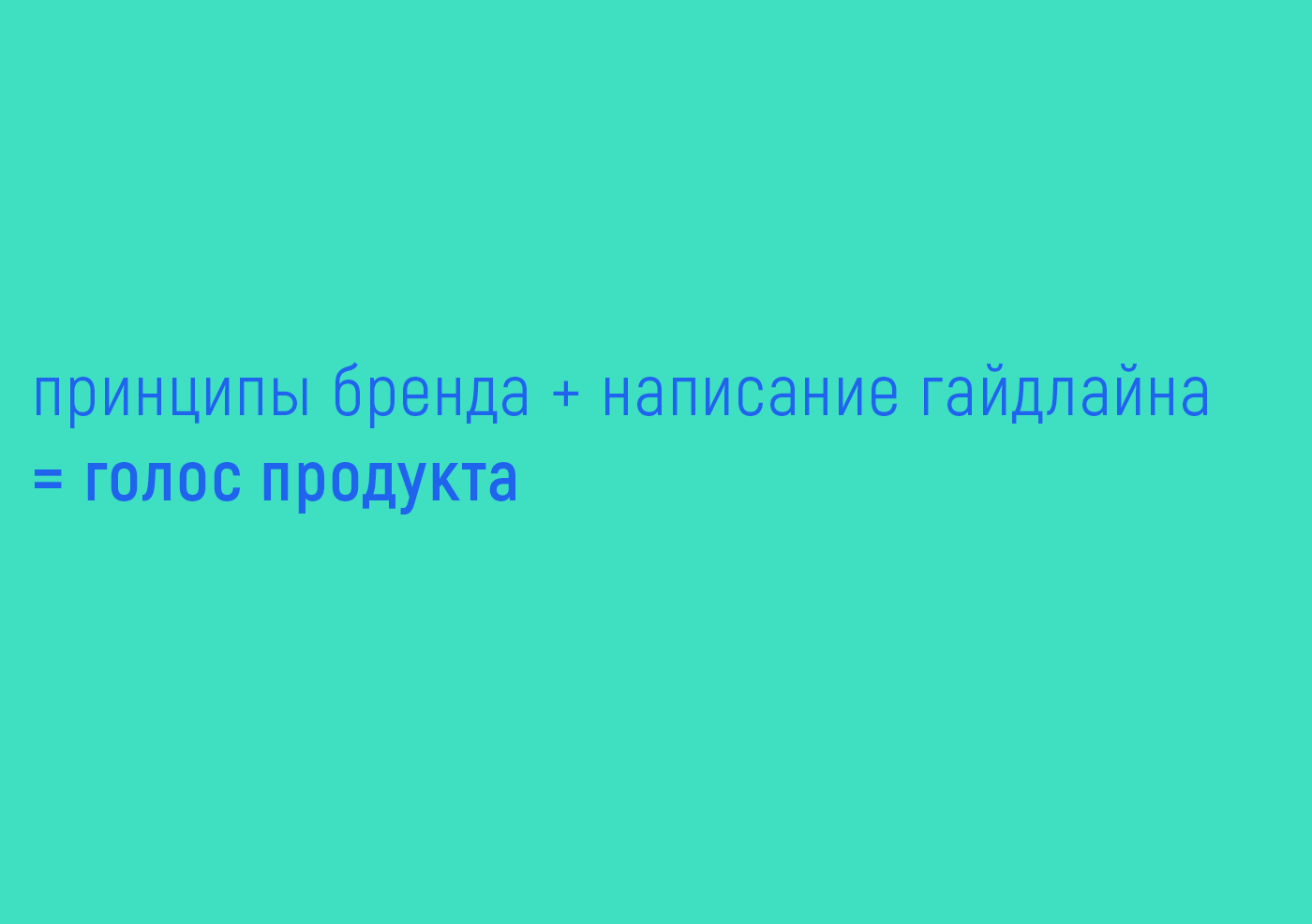
1 What is tone and voice and why are they important
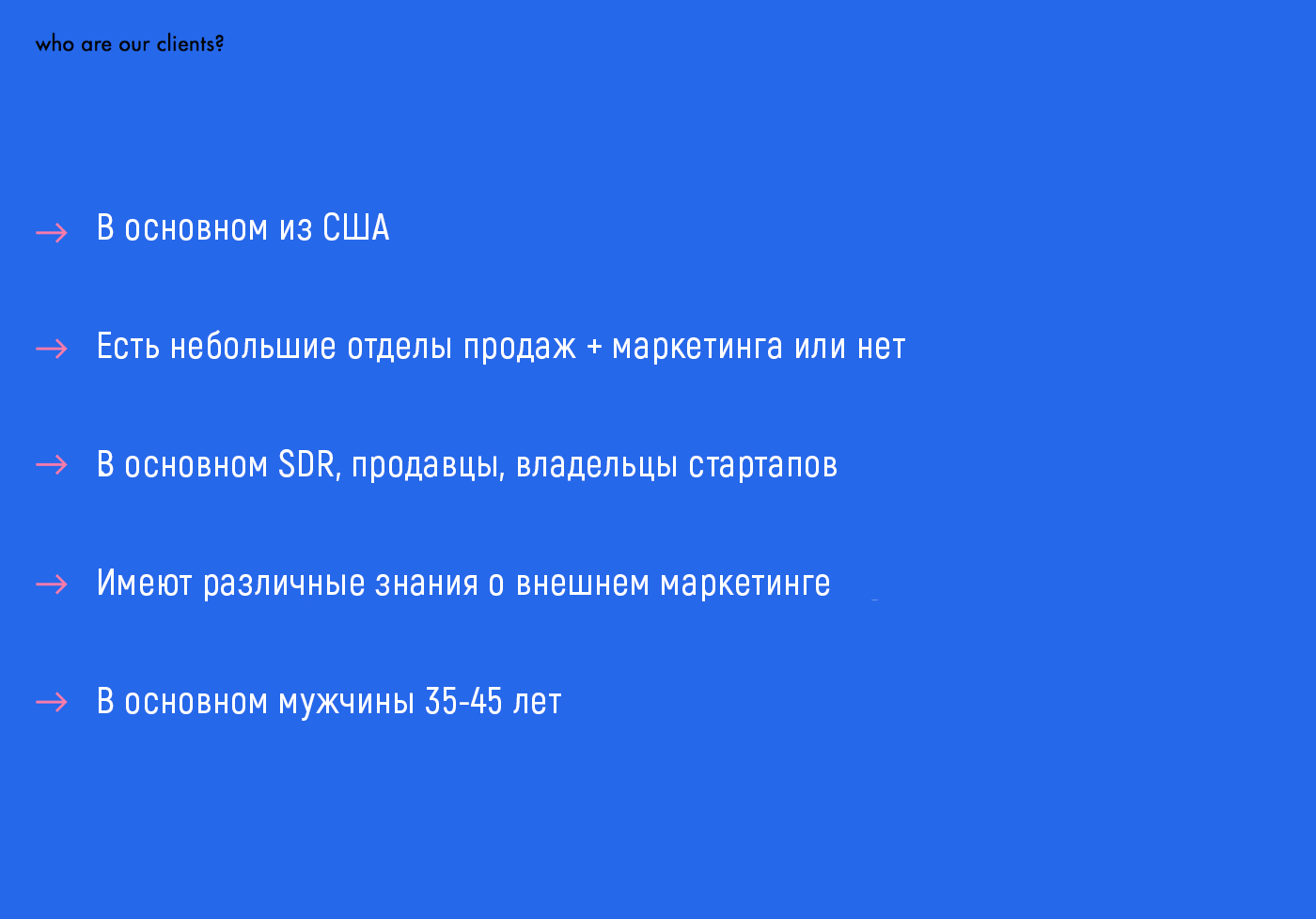
2 Who are our customers?

3 What is “individuality” of Growbots and getting to know our image (Mark)
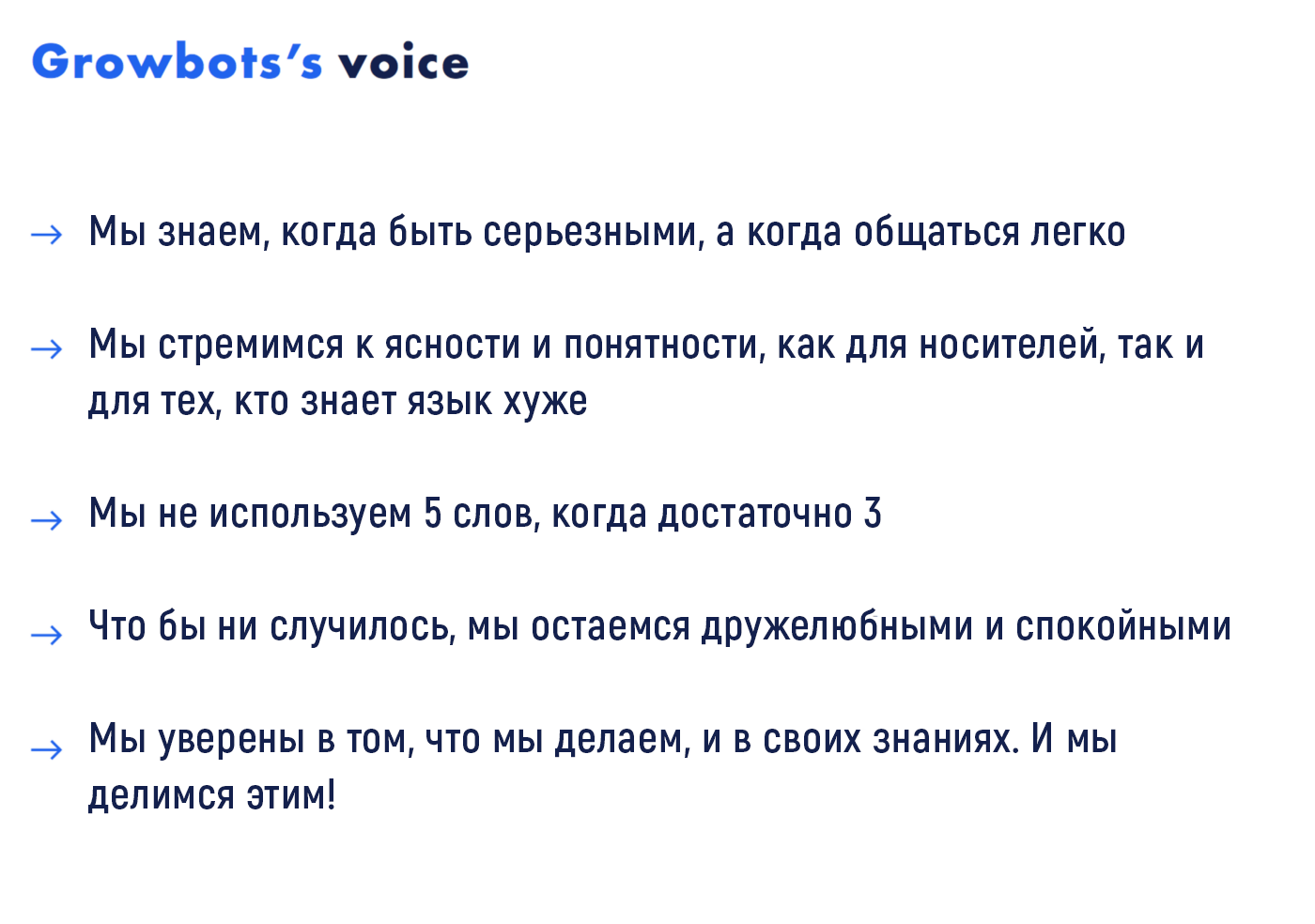
4 What is our voice
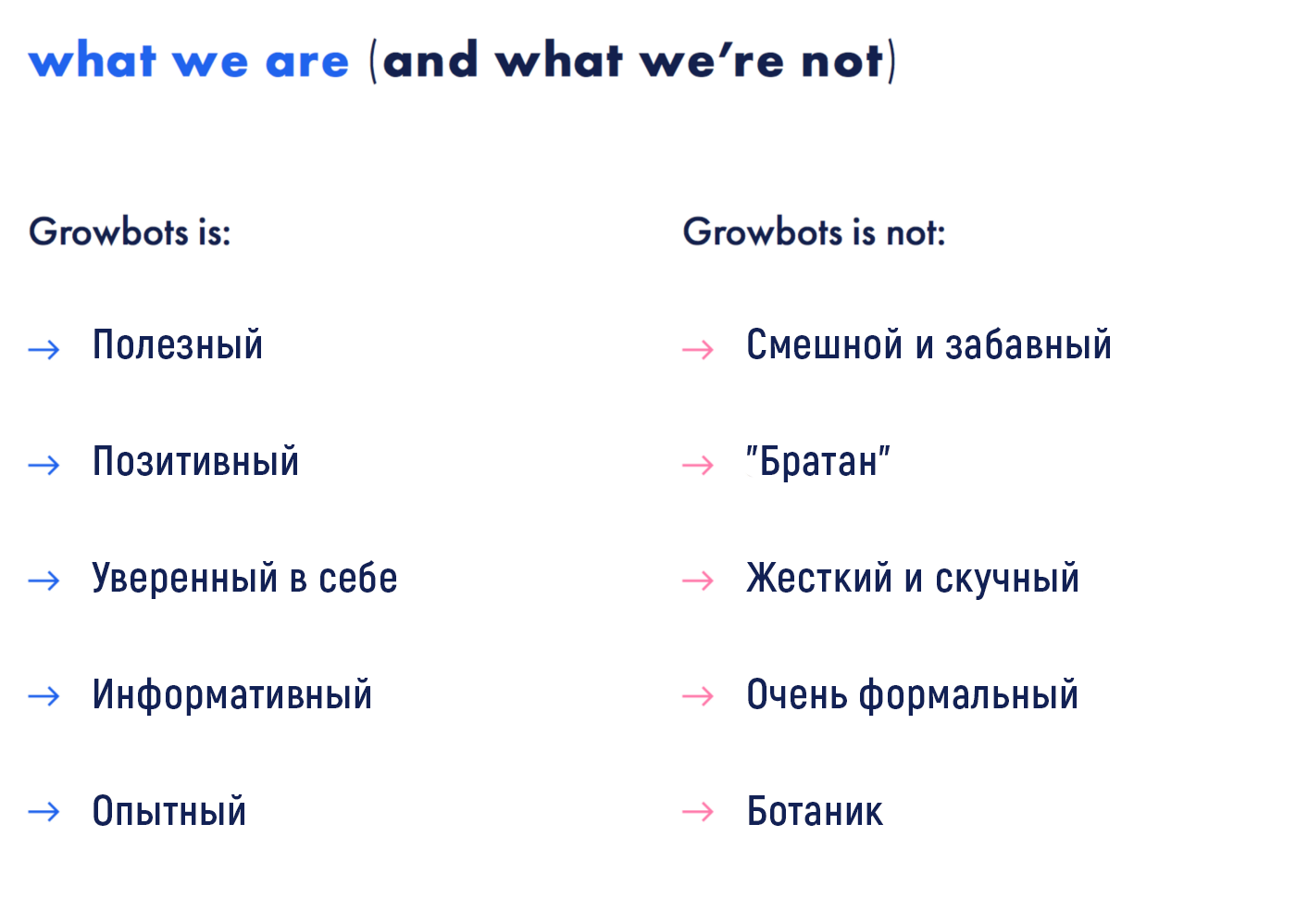
5 Who we are and who we are not

6 Several writing rules on behalf of our brand, with explanation and tips
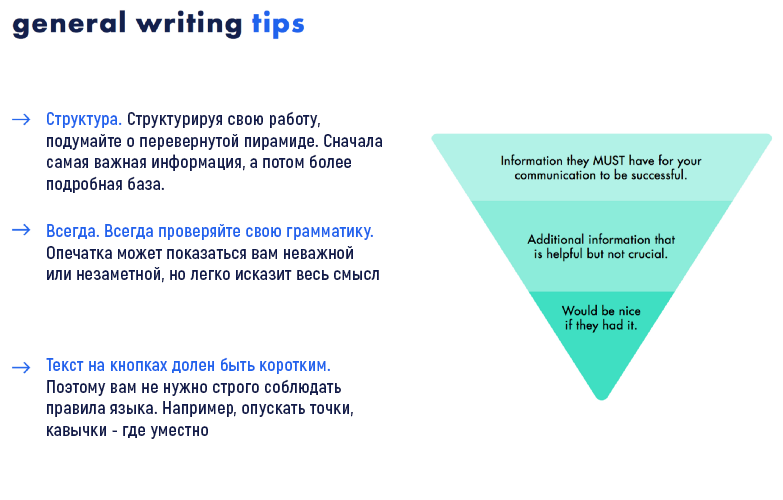
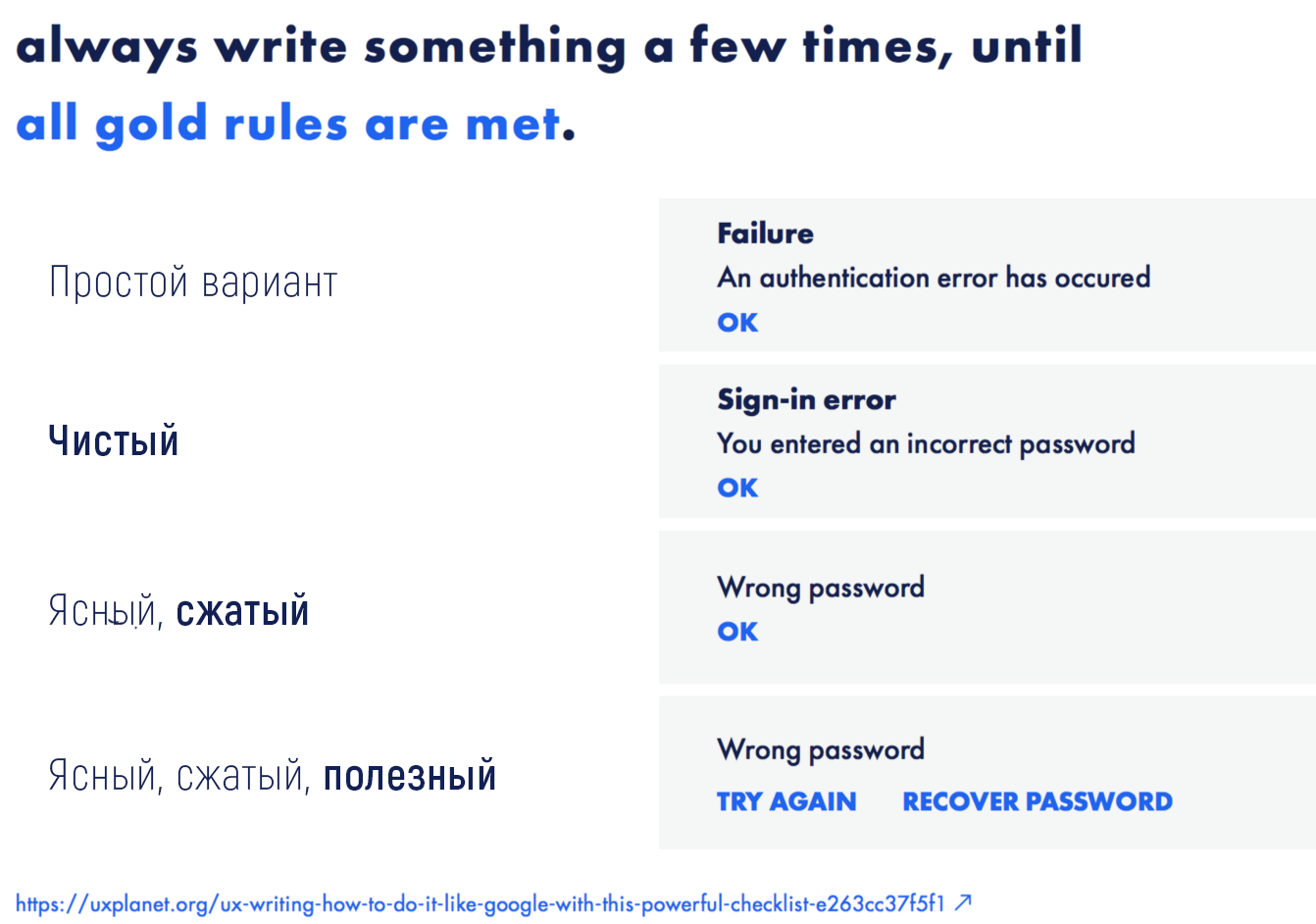
7 General writing tips. For example, what times to use, how to structure sentences, phrases to avoid, etc.

8 Examples of Good and Bad Phrases
After creating the guides, I introduced them to product owners, developers, and other people working on the Growbots application.
I bring to your attention a translation of the article " Creating your product's tone and voice " by Kaja Laura Toczyska. As usual, thanks in advance to everyone who takes the time to read.

Working in a product development team has an undeniable advantage over other types of teams: you can delve into the project. In Growbots (a platform for automating external sales, - approx.), after a year of working on a complete redesign, the stage has come when we were able to focus on polishing and fixing our previous work. Since we did not have a UX writer, it was necessary to complete work on a large release in a short time, and the texts in the application should have been normal anyway. All of these button names, messages, and errors definitely lacked uniformity, and - which I deeply regretted - their own tone and voice.
When calmer times came, I proposed to improve the text part of the application and develop my own tone and voice. Since I first worked with such a project (and my level of English is lower than even among native speakers), I would like to share our process with you. I hope that some of our experience will be useful for your company.
What is voice & tone?
This is how you express the nature of your company in communicating with customers at each contact. This is how you sound, what words you use, what atmosphere you create in your letter. Your tone and voice are everywhere - every message your customers exchange, every text on your site, every slogan in your advertisement.
“The voice of the brand is a focused, consistent expression of the brand through words and text styles that attract and motivate. It’s true: the identity of your brand is largely determined by the words you use and the sentences you write. ”Why is it important
Quote from larsen.com
- This is an expression of your core brand values.
- This creates a more humane image of the company.
- It fosters people's trust and affection for the brand.
- It distinguishes among competitors
Different messages = different tones
Your brand can (and should) have a different tone for different types of messages. On my example, I will tell you why. You yourself, and your character does not change much. But your tone largely depends on the situation in which you are, and on the person with whom you communicate. When you talk with your friends, you are probably relaxed, use slang, joke, and sometimes even express yourself. But when you are at the company’s official meeting, you probably follow your own words, take yourself more seriously and try to make a good impression. It is just a change of tone, while remaining the same person.
You need to project this knowledge onto the tone of your brand. When sending messages to the user — for example, errors, tips or feedback — the tone should change slightly. This is very important to indicate when preparing the voice & tone manual.
Now let's move on to the very process of creating recommendations on the tonality and voice of a product / brand, etc.
Stage 1 - Research
The first thing I did: quickly looked through the sites of our competitors and their tech support pages for tonality and voice. This simple operation will help you understand how you can distinguish your product / brand from others, as a unique tone and voice can become a huge differentiating factor. Pay attention to the words and phrases that they use, their tone (more formal or everyday?) And consistency among themselves.
Next, I looked at how we communicate with customers now, studied marketing materials (website, blog), and listened to successful negotiations with customers. I selected a few posts that, in my opinion, best reflect our current tone.

Stage 2 - Exchange of knowledge in the company
To make sure that everyone has the same idea of our tone and voice, I organized a seminar, inviting people from the team of designers, marketers and customer service managers - people who communicate on behalf of our company every day.
We tried to talk about who our customers are, what they do and how we currently communicate with them. Then we tried to find out how we all see Growbots, highlighting several features that we associate with our company (for example, the desire to be useful, natural in behavior, friendly). We learned that our vision is very similar. Everyone more or less saw Growbots as a young man (we are a startup), very useful, who studied everything on his own and likes to share this knowledge with others.
Our head of the UX, Peter, printed a photograph of a group of people and asked us to point out the person in the photograph, who, in our opinion, is most similar to Growbots. Most people chose the same person, and it really showed us that our vision is very holistic.
Now that we had a human image similar to Growbots (we called it Mark), we did the following exercise, which really helped us translate our vision into something more tangible. We presented that Mark has his own store with data on prospects, and the buyer enters this store. Then we wrote a conversation that we expected to happen in such a situation.
We went through all the scenarios - from the beginning of relations with the client, through some of his problems and small achievements, before the client decided to stop using our services. In different cases, we changed the tone. For example, when a client was angry that something was not working, Mark was very reassuring and helping. And when everything worked out for the client, Mark was cheerful and encouraging, using less formal words.
Having finished the work, we assigned one category to each phrase of Mark:
- Positive information
- Neutral information
- Answer to the problem
Then we analyzed these phrases and marked them in the matrix. The matrix consisted of two axes:
- How professional is the information
- How energetic was Mark, conveying information
Through this exercise, we were able to correlate the types of messages and the tone that we want to use in these situations.

Stage 3 - Guideline
With all this information, I was able to create a guide for our tone and voice. It consisted of several sections with 1–6 slides per section. Below you can see slide samples for each section:

1 What is tone and voice and why are they important

2 Who are our customers?

3 What is “individuality” of Growbots and getting to know our image (Mark)

4 What is our voice

5 Who we are and who we are not

6 Several writing rules on behalf of our brand, with explanation and tips


7 General writing tips. For example, what times to use, how to structure sentences, phrases to avoid, etc.

8 Examples of Good and Bad Phrases
After creating the guides, I introduced them to product owners, developers, and other people working on the Growbots application.
A few final tips
- Do not do it for too long, because no one will find so much time to read
- Try to make the guideline aesthetic so that it is not only pleasant to watch, but also easier to read.
- Always supplement your recommendations with examples, otherwise it will be difficult for people to use them.
- Indicate which times should be used in different situations. I noticed that this is usually the most controversial area when different people work on texts
- Engage as many people as possible when creating the guide. Do not forget about marketing and customer service managers - usually they most often communicate with customers
About translation of illustrations
I was not sure how to better translate the images, and came to the current form: when some of the information on the images remained original. This is a kind of compromise regarding labor costs, time and transfer of important information to the Russian language. In addition, the matrix decided not to touch. I hope there will be no difficulties with its study. I would be glad if someone tells you how to do better in the future.
